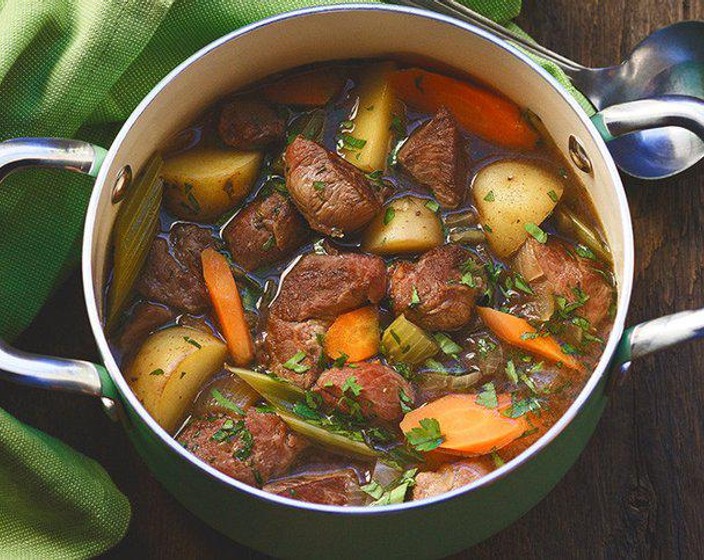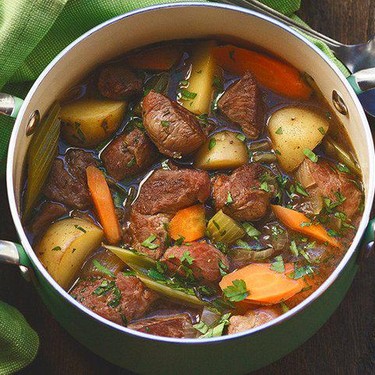Irish Food: The Hug You Didn’t Know You Needed




Ireland is not necessarily renowned for its cuisine. When you think of Ireland, you might envision rolling green hills, lifting a pint in a cozy pub, sheep dotted across a rugged landscape, or Conor McGregor flexing. But you might not realize that those green hills surround peat bogs that give Irish whiskey its signature smokiness. That pint of Guinness adds robust flavors to meat and dessert dishes alike. And next to that pint, you’ll often find distinctly Irish succulent lamb staples. I haven’t even mentioned potatoes yet! The point is, Irish food has gotten a bad rap, but I’m here to tell you about this delicious, fresh, and hearty cuisine that’s full of history and heart.
"potato bread, gratin--the list goes on. Brought to Ireland in the late 1500s, the Irish diet was forever changed, and now, a meal in Ireland is incomplete without these starchy beauties.
Irish cooking is rife with history. In particular, there’s some great lore around the beginnings of the Shepherd's Pie. Traditionally made from table scraps, affordable vegetables, and the generally unwanted cuts of mutton (the meat of an adult sheep), Shepherd’s Pie slowly simmers tough, seemingly inedible meat in a gravy of root vegetables before being topped with mashed potatoes and then baked. The slow cooking makes the mutton fall-apart-tender, moist, and flavorful, so that no piece of the animal goes to waste and all of it is mouthwatering.
One take on its origin surrounds the story of Irish peasant women’s solution to poverty, limited access to ingredients, and convincing their families to eat leftovers for the third week in a row. In the early 1700s, before Shepherd’s Pie was thusly named, it was called Cottage Pie, in reference to the cottage homes of peasants.
Irish Stew has a very similar origin story--a happy mix of otherwise unwanted (but still edible) leftovers--and is just as delicious. Stew feels like home in a bowl or a wool jumper made of warm, flaky lamb, or beef chunks and happiness. But you can decide for yourself; just be sure to always couple a hearty stew with a 12th-century favorite: wheaten bread and butter. You won’t regret it.
From creative table scraps to buttery potatoes, the Irish peasant defined what we think of as traditional Irish food today.
Sheep aren’t the only animals Ireland has in abundance, and with as many cows as Ireland boasts, you better believe the dairy game is strong. Yeah, the cheddar is great, and Kerrygold butter has a sizable and warranted cult following, but I’m here for the cream. Irish dairy and cream, in particular, is the star of some of Ireland’s most iconic desserts, like honeycomb ice cream, the Iced Finger, bread and butter pudding, biscuit cake, Bailey’s cheesecake, pavlova (a borrowed tradition made Irish with time), or as the perfect top to rhubarb and custard tart or Armagh apple tart.
Not all desserts require utensils, and not all heroes wear capes. Enter: the Irish Coffee. You could argue that the star of this adult treat is the whiskey, but the cream is equally as important. Floating perfectly on top of a mixture of coffee, whiskey, and sugar, the cream adds depth, richness, and coziness to the Coffee, making it feel more like a dessert than just a saucy after-dinner drink.
Then, there is Banoffee. Although English in origin, the Irish have taken Banoffee in as one of their own and, finally, after 800 years of colonization, England has given something back (ha just kidding 👀). A mix of banana, toffee, and cream, Banoffee takes a lot of shapes. They're all delicious, but the Banoffee Pie is probably the most recognizable. A goopy, sweet, sticky layer of toffee is followed by a layer of ripe, fruity bananas and topped off with a final layer of fresh whipped cream (naturally sweet and not from a can), all on top of a cookie crumb pie base (traditionally Digestive biscuits), and it is everything. If you have never experienced the joy and triumph of this dessert, I strongly recommend eating (or making!) one immediately. Your life will forever be split in two: before you had Banoffee, and after.
The world has agreed that Guinness is delicious, and even though it may not have proven to be the health tonic 20th-century doctors liked to recommend to iron-deficient pregnant women, it has endured as a tonic for the soul. The recognizable creamy, malty bitterness of Guinness improves all things: ice cream, steak and Guinness pie, chocolate anything, stews, Tuesdays. If Guinness is a part of it, it’s going to be incredible.
Irish food is an entire cuisine dedicated to making you feel warm from the inside out, and this article is just scratching the surface. Try some of the recipes I linked to throughout the article (they’re amazing!) to get a taste of Éire without having to leave your kitchen. Until next time, slán agus beannacht!
Irish food is an entire cuisine dedicated to making you feel warm from the inside out, and this article is just scratching the surface. Try some of the recipes I linked to throughout the article (they’re amazing!) to get a taste of Éire without having to leave your kitchen. Until next time, slán agus beannacht!